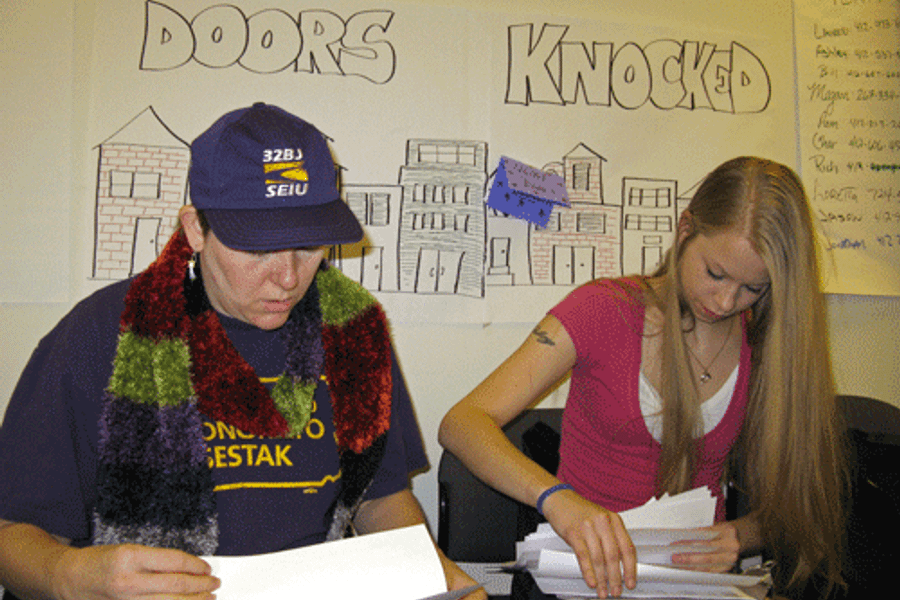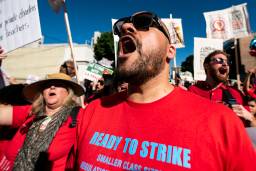
Washington Post columnist Harold Meyerson recently examined the developing trend in which unions abandon the workplace to become pressure groups divorced from collective bargaining and the workplace. As an example, Meyerson discussed the Service Employees International Union (SEIU) campaign to canvass low income neighborhoods to sign up working people into a community-based organization.
“The goal isn’t to enroll the people behind those doors in a conventional union” notes Meyerson, “but, rather, into a mass organization of the unemployed and the underpaid that can turn out votes in 2012 and act as an ongoing pressure group for job creation and worker rights during (presumably) Barack Obama’s second term.”
Like SEIU, an increasing number of union activists and theorists are looking to center union strategy far from the workplace. Rather than relying on the traditional union tactics of organizing, collective bargaining and political action, many trade unionists are instead focusing on protests against corporate targets and community organizing. Such actions get members into the streets to directly confront corporate profiteers and allow unions to organize around broad-based themes.
But as commentator Randy Shaw notes, the idea that building “some new and amorphous ‘mass organization’ that will help elect and then pressure pro-union politicians reflects a strategy that has already failed, and ignores that union power is based much more on the success of workplace organizing.”
Indeed, many recent labor books and articles promote strategies far removed from the traditional home of the labor movement — the workplace. Thus, we have calls to focus on building regional worker rights campaigns, citywide workers assemblies, and to move beyond collective bargaining to a broad-based populism promoting consumer mortgage strikes rather than worker strikes.
All good stuff, but one must ask where do workers, workplace organizing and collective bargaining fit into these visions of trade unionism? (For counter viewpoints promoting strategies rooted in the workplace, see an emphasis on member mobilization, union democracy and my own thoughts on reviving the strike.)
This shift away from the workplace, however, poses some very important questions about the function and purpose of trade unionism. Can the labor movement become a mass organization, divorced from the traditional concerns of the labor movement, workplace organizing and collective bargaining? Or is there something special about trade unionism — a historic role — that makes it different from other protest organizations?
Labor’s historic role
For the first 150 years of trade unionism, the central mission of trade unionism was to change the terms governing the sale of human labor. At the height of union power in the United States, through collective bargaining backed by a powerful strike, unions changed the wage structures of entire industries and established standards for union and non-union workers alike.
Unions won healthcare, pensions and work rules that forced employers to treat workers like human beings. On the legislative front, unions fought for minimum wages and overtime protections, which established legal minimums below which human labor could not be sold. Such forms of trade unionism disrupted the “normal” operations of labor markets and as such struck at the heart of power and privilege in society in ways other protests groups can never do.
Digging deeper, when trade unionists engage in collective bargaining, they are reaffirming the humanity of workers. To anti-labor conservatives, in the recent words of U.S. Representative Steve King of Iowa, human “labor is a commodity just like corn or beans or oil or gold, and the value of it needs to be determined by the competition, supply and demand in the workplace.”
In other words, Representative King and his corporate cronies view human beings as things, to be bought, sold, used up and discarded when no longer useful. Fueled by such beliefs, anti-labor conservatives are mounting attacks against child labor laws and any other laws they consider interfering with the market in the sale of human labor, including laws mandating fair wages for federal construction projects.
Trade unionism at its best, however, long challenged this corporate-centered viewpoint. Unionists fought for and won respect on the job, pay far above what the “free market” would dictate, and limitations on management’s control over the workplace. The struggle for power on the shop floor — for work rules and seniority rights — stemmed from belief that just because workers are forced to sell their labor for a period of time, they don’t give up their humanity. That’s another reason why the labor movement cannot surrender our most important battleground — the workplace.
At its best, trade unionism is unlike any other form of organization in society. Strong organizations, based in the workplace, allow working people a vehicle to become active in their workplace and the broader community. Most people spend a good part of their waking hours at work. In an alienating society, work has a social aspect which has long been an important junction for workers of different races and backgrounds to come together to fight for common goals.
While most community organizations are dominated by middle-class forces, unionism has self-consciously been a bastion of working class leadership. (All too many middle-class activists, upon entering the labor movement, ignore this essential feature of trade unionism. To them, the new agents of history are the research departments of international unions, the organizing departments, or the staff of central labor councils who conduct community outreach.)
For all these reasons, corporate America has always held a special vehemence for trade unionism, with some of the greatest legislative battles involving the rules governing collective bargaining. Judges, the traditional villains of the labor movement, singled out unionists for special rules restricting free speech rights. Constitutional protections have been thrown aside as judges have placed limitations on our rights to picket, assemble and free speech in excess of those afforded other groups in society. Certainly, labor’s enemies do not view trade unions as just another protest movement.
Finally, the battle for workers rights will be won in the workplace. Either trade unionist figure out methods of taking on corporations and improving workers’ lives or trade unionism will become extinct. In an article in the New Labor Forum, ILWU organizing director and veteran union organizer Peter Olney makes a compelling argument that the future of unionism lies in workplace struggle.
Olney discusses one of last year’s most intense workplace battles, in which miners in the isolated West California town of Boron took on international mining conglomerate, Rio Tinto. Using a variety of tactics, and enduring a 105-day lockout, workers stood up to Rio Tinto, scoring a defensive victory, in which some but not all of management’s concessions were beat back.
Olney argues that such battles are key to reviving the labor movement:
Union leaders search for large-scale organizing campaigns that, if successful, could spark a resurgence. They hunt for ambitious, winning campaigns that could come to symbolize the rebirth of labor. Rather than identifying and building on the existing struggles of the organized working class, their strategies are always cast as “new” organizing campaigns. It’s time to recognize that winning defensive battles like Boron is the key to labor’s renaissance.
What Onley points to here, and what labor history clear tells us, is that when the labor movement comes roaring back — and it will — it will be because workers and their unions take a stand to fight back and find new ways of confronting power and privilege in society. Such a movement, of necessity, will be firmly rooted in the workplace.
Joe Burns, a former local union president active in strike solidarity, is a labor negotiator and attorney. He is the author of the book Reviving the Strike: How Working People Can Regain Power and Transform America (IG Publishing, 2011).







